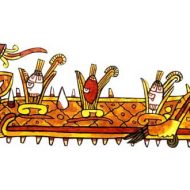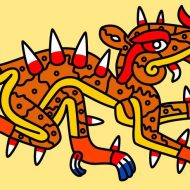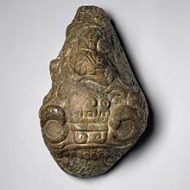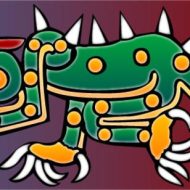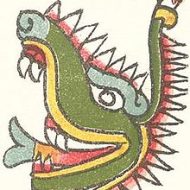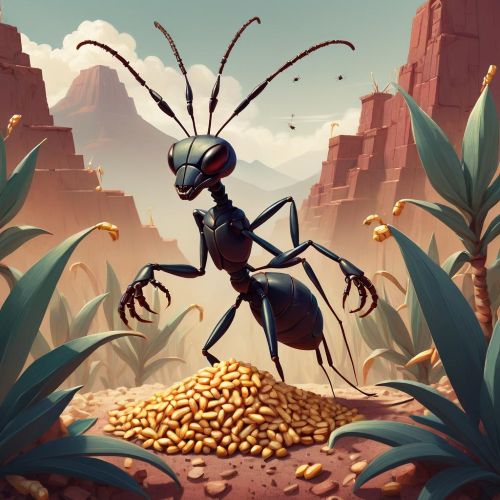Cipactli : The Primordial Crocodile of Creation
Listen
At a glance
| Description | |
|---|---|
| Origin | Aztec Mythology |
| Classification | Animals |
| Family Members | N/A |
| Region | Mexico |
| Associated With | Earth, Volcanoes, Sacrifice |
Cipactli
Introduction
At the dawn of Aztec cosmology, when the world was still shapeless and the seas covered everything, there lurked a monstrous being known as Cipactli — the insatiable crocodile whose body was the foundation of creation itself. Both feared and worshipped, Cipactli was a cosmic hybrid that existed before the gods brought order to the universe.
Described as part fish, part toad, and part crocodile, Cipactli was an ever-hungry creature whose jaws spanned dimensions. Its devouring nature represented chaos, but from that chaos emerged creation. In Aztec myth, the gods Tezcatlipoca and Quetzalcoatl tore Cipactli apart to form the earth, giving rise to mountains, rivers, and valleys — a sacred act of violence that defined life as an endless cycle of consumption and renewal. Cipactli thus embodies the Aztec understanding of the cosmos: that creation always demands sacrifice — a balance of destruction and divine rebirth.
Physical Traits
Cipactli’s form is monstrous and ambiguous, combining the features of amphibians, fish, and reptiles into a single cosmic being. It is described in Aztec codices as having jagged teeth, multiple mouths along its body, and a scaly hide tougher than stone. Some depictions show it with a serpent’s tail and toad-like limbs, others as a crocodile floating on the primordial waters.
Each mouth of Cipactli is said to represent a cosmic gate through which life enters and leaves the world. Its open maw symbolizes the earth’s surface — the fertile but dangerous realm between heaven and the underworld. In Aztec art, these mouths sometimes appear as the entrance to temples or caves, emphasizing its identity as both creator and consumer. The earth’s jagged terrain was believed to be the result of its resistance when the gods tore it apart. Thus, every mountain and valley bears the mark of Cipactli’s divine anguish.
Family
Cipactli does not belong to a family in the human sense but is one of the earliest primordial entities in Aztec mythology. It predates the gods and represents the first manifestation of matter — raw, untamed potential.
Some legends describe Cipactli as a companion of Tlaltecuhtli, the earth goddess, with whom it shares many attributes. In other versions, Tlaltecuhtli is actually a feminized form of Cipactli, suggesting that the two are different aspects of the same being: the devouring earth that creates life through death.
Within the Aztec calendar, Cipactli is also the first day-sign — a symbol of beginnings and birth. As the foundation of time and existence, it is the ancestor of all life, making it both a progenitor and a predator.
Other Names
Cipactli’s name in Nahuatl means “crocodile” or “caiman,” but its symbolism extends far beyond a literal animal. In Maya mythology, its equivalent is Itzam Cab Ain, the earth-bearing crocodile, and among the Mixtec it appears as a cosmic caiman. Alternate epithets include Tlaltecuhtli’s Shadow, The Devourer of Stars, and The Earth Crocodile of Chaos. Across Mesoamerica, the creature is a recurring symbol for the living earth — hungry, fertile, and restless.
Powers and Abilities
Cipactli’s primary power is creation through consumption. Its body becomes the world, its blood the waters, and its breath the winds. It represents the ancient truth that all life is born of destruction — that to create, one must first consume.
It is also said to devour time itself, its hunger never ending. Even after being slain, its spirit demands regular sacrifice to appease its pain — the cosmic justification for human offerings in Aztec ritual.
In many depictions, Cipactli can move between realms, swimming in the primordial waters of the underworld and surfacing into the sky as a celestial monster. It is immortal, its body transformed but never destroyed. When volcanoes erupt or earthquakes strike, Aztec priests believed it was Cipactli stirring beneath the world. Through its sacrifice, humanity was given life — but through its hunger, humans must repay that debt forever.
Modern Day Influences
Cipactli’s influence persists across Mesoamerican culture as a symbol of both creation and sacrifice. In modern Mexico, archaeologists and artists see its imagery in temple murals at Teotihuacan and stone reliefs from the Tenochtitlan temple complex. Its jagged-toothed maw appears on the Aztec calendar stone, marking the beginning of time.
Contemporary artists reinterpret Cipactli as an ecological symbol — the living Earth that devours what is taken from it. In Latin American literature and fantasy fiction, it appears as a primordial leviathan, a force of nature representing the endless hunger of civilization itself.
Spiritually, Cipactli has been reclaimed by modern Mesoamerican revivalist movements as a symbol of balance and respect for natural cycles — a reminder that all creation carries a price. Its name is also invoked in neo-Aztec ceremonies to honor the foundations of the earth and the sacrifices of the ancestors.
Through myth, Cipactli continues to swim beneath modern consciousness — its hunger no longer for flesh, but for meaning.
Related Images
Source
Boone, E. H. (1983). The Codex Borgia: A Full Color Restoration of the Ancient Mexican Manuscript. Dover Publications.
León-Portilla, M. (1993). Aztec Thought and Culture: A Study of the Ancient Nahuatl Mind. University of Oklahoma Press.
Townsend, R. F. (2000). The Aztecs. Thames & Hudson.
Taube, K. (1995). The Major Gods of Ancient Yucatan. Dumbarton Oaks Research Library.
AncientOrigins. (2022). Cipactli: The Insatiable Crocodile of Aztec Mythology. https://www.ancient-origins.net/myths-legends-americas/cipactli-0018991
WorldHistory.org. (2023). Cipactli – The Primordial Monster of Creation. https://www.worldhistory.org/Cipactli/
Mexicolore. (2022). Aztec Myth: The Creation of the World and Cipactli. https://www.mexicolore.co.uk/aztecs/stories/cipactli
Wikipedia contributors. (n.d.). Cipactli. In Wikipedia, The Free Encyclopedia. https://en.wikipedia.org/wiki/Cipactli
Frequently Asked Questions
What is Cipactli the god of?
Cipactli is not technically a god but is often used to symbolise new beginings and the creation of the earth.
What powers did cipactli have?
This animal had an insatiable hunger which threatened to devour ever creation on earth. The existence of multiple mouths also ensured that this consumption was at a rapid pace.
Is Cipactli Aztec or Mayan?
Cipactli is one of the major characters in Aztec mythology. The Cipactli is also quite heavily featured in Mayan mythology and it is also considered to have heavily influenced the much later civilizations of the region.
What are other names for Cipactli?
Cipactli was also referred to as Imix.
Why did the gods kill Cipactli?
The gods realized that all their creations would eventually fall into the void and be consumed by Cipactli, and they decided to destroy it.


